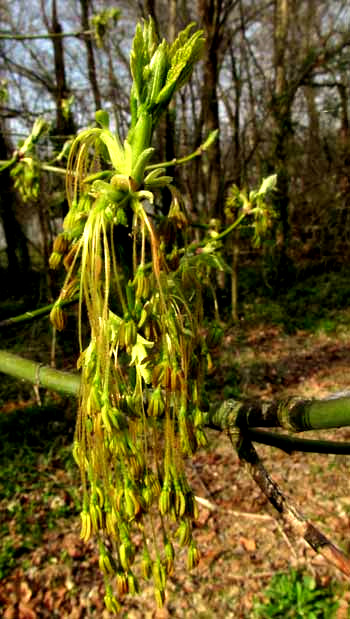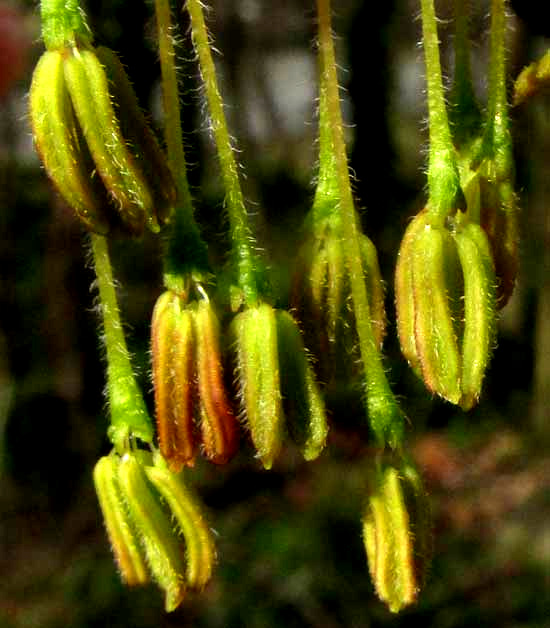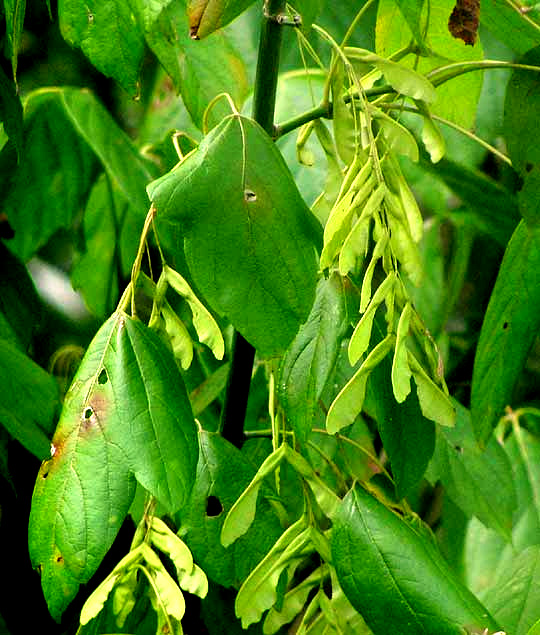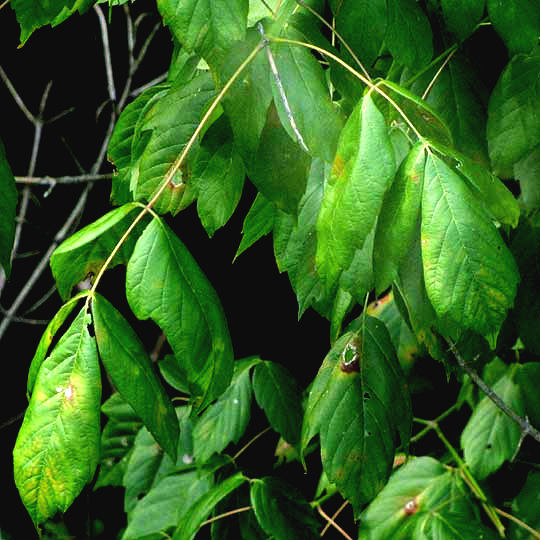Excerpts from Jim Conrad's
Naturalist Newsletter
from the April 9, 2017 Newsletter issued from Calhoun, rural western Kentucky, USA
BOXELDERS FLOWERING
Here in western Kentucky most trees still are winter-leafless, but many are issuing flowers, whole trees sometimes displaying pastel hues as untold numbers of blossoms adorn otherwise naked branches. In local swamps and along streambanks one of the most conspicuous of such trees is the Boxelder.

Above you can see a dense cluster of drooping stamens dangling from male flowers. A close-up of the stamens' green-banana-like, pollen-filled anthers is shown below:

Each male flower normally produces four to six stamens. Neither the male nor female flowers bear petals. I'd like to show female flowers but so far I can't find any, despite considerable searching, so this is something of a mystery.
from the July 29, 2012 Newsletter issued from the woods of the Loess Hill Region a few miles east of Natchez, Mississippi, USA
BOXELDERS FRUITING
Biking across an old-time, one-lane wooden bridge over a nearby creek I was tickled to see across the railings the top of a Boxelder tree, ACER NEGUNDO, heavy with paired, samara-type fruits. You can see a typical branch below:

Being on the bridge was important for that picture, for the tree's lower branches were fruitless.
People familiar with maple species such as Sugar, Red and Silver Maples often are surprised to learn that Boxelders are real maples, too -- members of the genus Acer. The paired, winged fruits are typical maple, but what's not like those other species are the leaves. The vast majority of the more than 100 maple species bear simple leaves -- leaves composed of a single, flat blade. Boxelder leaves are compound, as shown below:

That picture is mostly filled with two leaves, each comprising five leaflets. Their slender petioles attach opposite one another on the green stem at the picture's top, center. The greenness of the main stem passing vertically through the picture's center is another peculiarity, for not many trees bear year-old, green twigs.
Also among the maples Boxelders are a little unusual in being completely "dioecious" -- trees bear either male or female flowers, but not both.
As a kid on the Kentucky farm the Boxelder was one of the first trees I learned to identify because most of the shade trees around our house were Boxelders. My father chose to plant them because they were so fast growing, grew into pretty shapes and produced good shade. In late summer their leaves did tend to wilt, curl up, turn brown, and drop off early from diseases, but that didn't seem to affect the tree's general growth throughout my entire childhood. Boxelders are known for being plagued by a variety of diseases. The ones in our picture look pretty droopy and show signs of fungal infections themselves. Also, Boxelders' fast-grown branches tend to be weak and brittle. I remember picking up many big limbs broken from them by storm winds and freezing rain.
Boxelders display an interesting area of distribution. They're native from well into south-central Canada to the Texas Gulf Coast and throughout most of the eastern US, but not on much of the eastern Coastal Plain, and not in New England. Island populations are scattered here and there in the western US and at higher elevations in southern Mexico and Guatemala. The Mexican and Guatemalan communities were left there as the last ice-age glacier retreated in the north, with many northern-forest species, instead of following the cool weather back north, sought cooler climes at higher elevations.
Boxelders are vigorous, adaptable trees. In much of Europe as well as Asia, South America and Australia invasive communities of Boxelders have become established. Also, in the wild, normally Boxelders grow along streams, in swamps and such, but if you transplant them into a dry, suburban lawn normally they do pretty well. In fact, a number of cultivars have been developed, including 'Auratum' with intensely yellow autumn leaves, 'Flamingo' on which young leaves emerge bright pink, and 'Variegatum,' with variegated leaves.